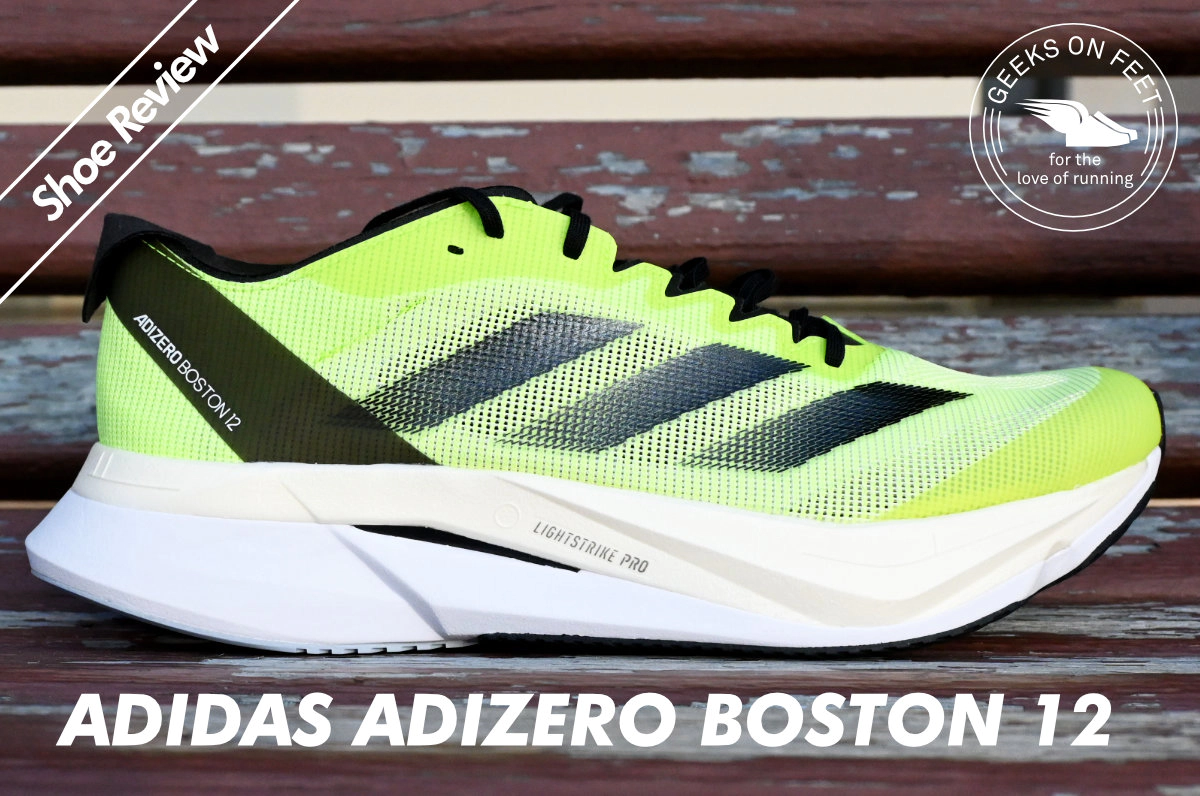
While Adidas Boston shoes have a rich heritage spanning 40 years, the modern iteration of the Adizero Boston series is relatively recent. It was only in 2010 when the Adizero and Boston shoe lines merged to create the Adizero Boston, a performance-oriented racing shoe. Now, in 2023, although the Boston line has maintained its focus on performance, it is no longer the primary racing shoe in the lineup. Starting with the Adizero Boston 10, it has become the preferred training companion to the Adios Pro, which serves as the super shoe racer in the Adizero line.
The Adizero Boston 10 (Read our Boston 10 review here) marks a significant departure from earlier Boston shoes, featuring a higher stack height. The Boston 12 continues to build on this design and is intended to be a daily trainer with the flexibility to be used for faster tempos.
Notably, the Adizero Boston 12 is one of the very few running shoes in the Adidas lineup that have been discounted in India. I purchased one during the recent Big Billion Day sale. I was eager to try it out based on positive reviews, despite having had a negative experience with the Boston 11 in the past.
So Is the Adizero Boston 12 the perfect training companion for the Adios Pro? Does it make a versatile daily trainer? Read as I explore its features, performance, and whether it truly lives up to its reputation.
To an untrained eye, the Adizero Boston 12 appears very similar to the Adios Pro 3 (Read our Adios Pro 3 review here), and the profile is quite similar, albeit slightly less aggressive. When placed side by side, one can observe that the Boston 12 features a more gradually tapered toe spring angle and a less aggressive heel bevel. Another noticeable difference is the dual-stacked midsole in the Boston 12.
From a technical specs perspective, the Boston 12 represents a significant performance upgrade compared to the Boston 11. The Boston 11 feels clunky when compared to the Boston 12. The Boston 12 has a 6mm heel-drop (with a 38mm heel and 31mm forefoot), while the Boston 11 has an 8mm offset. The stack height on the Boston 12 is reduced by 1.5mm to 38mm (compared to the Boston 11’s 39.5mm stack). The weight has also significantly decreased, with the Boston 11 in UK size 10 weighing 306 grams, while the Boston 12 in the same size measures 279 grams.
The shoe’s geometry strikes a good balance between rocker and classic styles. The rocker doesn’t feel overly aggressive but is much more pronounced than that of the Boston 11.
Midsole
The midsole of the Boston 12 shares a similar construction with the Boston 11. It features a dual-layered midsole with Light Strike Pro foam in the top layer, closer to the foot, and Light Strike 2.0 foam in the bottom layer. Glass fiber rods are incorporated into the midsole between the two layers. In comparison to the Boston 11, the foam quality in the Boston 12 is significantly improved. LightStrike Pro foam has a durometer of approximately 24 HA, while the new Light Strike 2.0 foam measures around 34 HA. When compared to the Boston 11’s 36 HA and 45, the new midsole foam is far superior and softer.
Upper
The upper undergoes a major upgrade too. It features a much lighter mesh construction that is extremely breathable. The suede elements from the Boston 11 are absent in the Boston 12, resulting in a much lighter and more supple upper that adapts well to the feet. The tongue is minimal, with minimal padding, making it very lightweight and more racer-like in feel.
Heel
The heel of the Boston 12 has minimal padding, resembling a racer more than a trainer. However, this might not be ideal, as the heel lacks the stiffness found in the Boston 11. There is a heel tab, similar to previous editions and other shoes in the Adizero line.
Outsole
Like many of the shoes in the Adizero line, the outsole of the Boston 12 is made of Continental rubber. The tread pattern is designed to provide traction on most surfaces, which is beneficial for a trainer. However, the outsole is notably thinner compared to that of the Boston 11.
I am currently in the midst of a marathon training cycle, and I’ve been searching for a reliable daily trainer with good bounce. I came across an article on Light Strike 2.0 and heard positive feedback about the Boston 12 in various running shoe forums. Given my less-than-satisfactory experience with the Boston 11, which felt clunky and made it extremely challenging to run at faster paces, I was somewhat hesitant. However, a 50% discount offer during the Flipkart Big Billion Day sale ultimately convinced me to make the purchase.
I’ve covered a distance of 170 kilometers with these shoes over the past 8 weeks. Primarily, I’ve used them for medium-long runs, typically around the half-marathon distance. I haven’t utilized them in any races, as that’s not my intended purpose for these shoes, and I wouldn’t recommend them for racing unless it’s the only pair you have.
To evaluate the shoe’s bounce and speed, I’ve taken it on a couple of hard tempo runs spanning 8 kilometers each. Additionally, I ran a 10-kilometer route on a soft trail around a lake bed to assess its traction.
The shoe takes some getting used to, as the minimal padding can make it somewhat uncomfortable during the first few runs. However, as you become used to it, running in the shoe becomes much more comfortable. The shoe truly shines during faster runs, offering excellent bounce and stability, making it an ideal companion for the Adios Pro. Despite being a bit heavier, I found it to be more suitable for tempo runs than the Takumi Sen 9, especially on uneven roads and typical road surfaces in India.
The shoe is perfect for medium-long runs, providing ample cushioning that can carry you all the way to a marathon. If I have to compare, the ride of the shoe resembles my older Adios Pro 2 more than any other neutral trainers on the market. The ride is bouncy but not overly soft, and I wouldn’t recommend it for longer runs where post-run recovery is the primary goal. For those purposes, you’d be better off with Invincibles and Superblasts.
The reduced heel drop of 6 mm means Boston 12 is more suitable for midfoot and forefoot strikers than heel strikers.
Fit and Comfort
The upper fits perfectly on the foot, especially once you’ve become accustomed to it after a few runs. While you can sense the lack of padding, the softer and more flexible upper doesn’t cause much discomfort. The toe box suits me well as my toe shape aligns perfectly with the shoe last. However, if you have a foot shape that is more square, with toes of similar height and a wide foot, you might need to explore other options. The forefoot and midfoot fit very well.
The main issue I encountered relates to the heel. Despite the soft heel counter, the lack of padding makes it uncomfortable. Moreover, the heel tends to slip, making faster runs more challenging. I had to experiment with the lacing to achieve a satisfactory heel fit. Depending on how well the heel fits, especially if your heel is narrow, you might have to consider going half a size smaller with the Boston 12.
Stability
Compared to its racing counterpart, the Adios Pro, the shoe feels notably stable. Given its 38mm stack height, it provides impressive stability, likely attributed to the firmer Light Strike 2.0 foam in the bottom of the midsole. Although it lacks specific stability elements, it doesn’t offer the same level of pronation control as stability shoes.
Road Grip
The shoe delivers decent road grip, making it practical for daily training with an emphasis on speed, particularly on Indian roads. While it performs well, it doesn’t match the level of grip offered by Puma Grip in the Nitro line from Puma. The shoe performs admirably on softer trails with pebbles. It handles corners effectively during tempo runs. The only challenge is with roads that have loose sand and construction debris.
However, I’ve noticed the outsole tread seems to worn out a bit, but that is not out of the ordinary.
Aesthetics & Ergonomics
The shoe has a great presence on the road, and looks like a racer. I really loved my colorway, which is officially called “Cloud White / Core Black / Lucid Lemon”. It doesn’t shout for any attention, but looks really great. It is easy to clean too.
Toe box
Forefoot
Heel
Size
Ventilation
Stability
Responsive
Cushioning
Grip
Ground Feel

Aravind is a techie, running geek, and a marathoner. He is a CrossFit Level 1 Trainer. He loves all things technology and technology in running, with special interest in running form analysis.